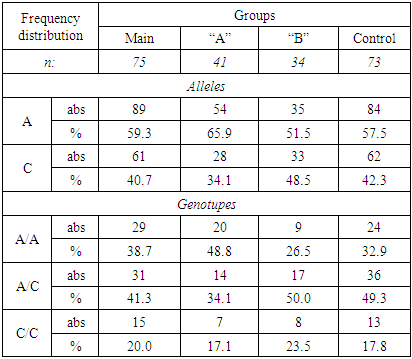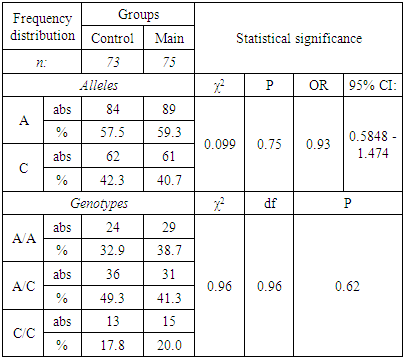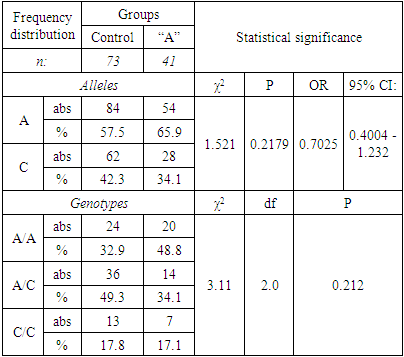-
Paper Information
- Next Paper
- Paper Submission
-
Journal Information
- About This Journal
- Editorial Board
- Current Issue
- Archive
- Author Guidelines
- Contact Us
American Journal of Medicine and Medical Sciences
p-ISSN: 2165-901X e-ISSN: 2165-9036
2019; 9(1): 439-442
doi:10.5923/j.ajmms.20190911.07

Evaluation of Polymorphism Gene AGTR1 (rs5186) in the Pathogenesis of Immune Microtrombovasculitis
Dilfuza Saburovna Matkarimova, Khamid Yakubovich Karimov, Kodirjon Tukhtabaevich Boboev
Department of Molecular Medicine and Cell Technologies, Scientific Research Institute of Hematology and Blood Transfusion of the Ministry of Health of the Republic of Uzbekistan, Tashkent, Uzbekistan
Correspondence to: Dilfuza Saburovna Matkarimova, Department of Molecular Medicine and Cell Technologies, Scientific Research Institute of Hematology and Blood Transfusion of the Ministry of Health of the Republic of Uzbekistan, Tashkent, Uzbekistan.
| Email: |  |
Copyright © 2019 The Author(s). Published by Scientific & Academic Publishing.
This work is licensed under the Creative Commons Attribution International License (CC BY).
http://creativecommons.org/licenses/by/4.0/

The AGTR1 gene rs5186 genetic polymorphism was detected among non-relatives of patients with immune microtrombovasculitis (Schenlein-Genoch purpura). In the main group of patients, compared with the control group, a slight decrease in the A / C genotype was noted (41.3% versus 49.3%). Along with this, the presence of the C / C homozygous genotype (20.0% versus 17.8%) was also detected in both groups. The frequency distribution of genotypes was statistically insignificant (χ2 = 0.96; df = 2, p = 0.62). The results suggest that the carriage of the polymorphic variant of the AGTR1 gene (rs5186) is not associated with the risk of developing immune microtrombovasculitis in people of Uzbek nationality.
Keywords: rs5186 polymorphism of the AGTR1 gene, Immune microtrombovasculitis (purpure of Shenlein-Genoch), Carriage, Predisposition, People of Uzbek nationality
Cite this paper: Dilfuza Saburovna Matkarimova, Khamid Yakubovich Karimov, Kodirjon Tukhtabaevich Boboev, Evaluation of Polymorphism Gene AGTR1 (rs5186) in the Pathogenesis of Immune Microtrombovasculitis, American Journal of Medicine and Medical Sciences, Vol. 9 No. 1, 2019, pp. 439-442. doi: 10.5923/j.ajmms.20190911.07.
Article Outline
1. Introduction
- Studies aimed at studying the pathogenetic mechanisms of immune microtrombovasculitis (IMTV) have proven that the disease is associated with a variety of factors, which allows it to be defined as multifactorial [8,9].Among the variety of these factors, a special place in the risk of IMTV formation is given to genetic components, which are based on the polymorphism of genes [3].According to literary data, the genes of the renin-angiotensin system, which play a key role in enhancing pro-inflammatory processes, are important for the development of IMTV [2,10].It is known that the renin-angiotensin system (RAS), along with the regulation of sodium homeostasis, blood pressure, is also involved in the process of inflammation [1].Considering that IMTV is a disease characterized by lesions of the blood vessels of the microvasculature and associated with the activation of endothelial cells, then there are opinions that RAS by participating in vascular tone modulation, possibly directly or through various factors, can also affect the vascular structure, in particular endothelin and nitric oxide [6]. Therefore, RAS may be involved in the pathogenesis of IMTV.The results of a number of studies have shown that polymorphisms of the PAC genes, in particular angiotensin II receptor 1 (AGT, AGTR1A, AT1R), are involved in the progression of nephropathy and proteinuria in IMTV [4]. It is assumed that polymorphisms of the RAS genes may be associated with the risk of developing IMTV due to their effect on the level of angiotensin [5].Considering the absence of any convincing evidence "for" or "against" the various proposed hypotheses about the pathogenesis of IMTV, we conducted a study to examine the role of the genetic polymorphism AGТR1 (rs5186) in the development of IMTV in people of Uzbek nationality.
2. Main Body
2.1. The Purpose of Our Research
- To study the role of the polymorphic variant of the AGТR1 gene (rs5186) in the occurrence of immune microthrombovasculitis in people of Uzbek nationality.
2.2. Material and Methods of Study
- The study included 75 adults aged from 16 to 80 years (the main group) of unrelated Uzbek patients with an established diagnosis of immune microthrombovasculitis (Shenlein-Henoch purpura) according to the modern classification criteria of EULAR, PRINTO and PreS (2010) [7].Of these, 41 patients were in the midst of a crisis (subgroup “A”) and 34 - in remission (subgroup “B”) of the disease. All patients were observed in the consultative and diagnostic clinic of the Research Institute of Hematology and Blood Transfusion of the Ministry of Health of the Republic of Uzbekistan in the period from 2017 to 2018. The control group consisted of 73 healthy unrelated persons of Uzbek nationality who had no history of inflammatory, allergic, systemic and renal diseases, matched by gender and age with the examined group of patients.Detection of AGТR1 polymorphism (rs5186) was performed using SNP-PCR on a programmable thermal cycler from Applied Biosystems 2720 (USA), using test systems from Litex (Russia), according to the manufacturer’s instructions.Statistical analysis of the results was carried out using the statistical software package "OpenEpi 2009, Version 9.3".
2.3. Results of the Study
- The results of a molecular genetic study of the polymorphic variant of the AGTR1 gene (rs 5186) showed that the frequency of allele A for conditionally healthy individuals in the control group was 57.5%, for the main group of patients IMTV - 59.3%. The share of allele C for conditionally healthy individuals was 42.3%, and among patients with IMTV in the main group it was 40.7% (Table 1). Differences between groups were statistically insignificant (χ2 = 0.099; p = 0.75; OR = 0.93; 95% CI: 0.5848-1.474). At the same time, the risk of IMTV in individuals in whom the polymorphism of the AGTR1 gene (rs 5186) was detected was less than one.
|
|
|
|
3. Conclusions
- Immune microtrombovasculitis is a multifactorial disease, in the formation of which an important role is played by genetic factors, which often determine its course [8,9]. The literature contains studies on the role of the genes of the renin-angiotensin system (RAS) in the development and course of IMTV [1,2,9]. The results of these studies suggest that due to the effect on the inflammatory processes in the body, polymorphisms of the ASD genes can be associated with the development of BMI.This study examined the genetic association between the development of IMTV and the AGТR1 (rs5186) gene polymorphism. The results of our studies showed that in the main group of patients, in comparison with the control group, there was an insignificant decrease in the detection rate of the A/C genotype (41.3% versus 49.3%). In addition, the homozygous C/C genotype was detected in both studied groups (20.0% vs. 17.8%). The distribution of genotype frequencies was statistically insignificant (χ2 = 0.96; df = 2, p = 0.62). The obtained results suggest that the carriage of the polymorphic variant of the AGТR1 gene (rs5186) is not associated with the risk of developing immune microthromovasculitis in people of Uzbek nationality.
 Abstract
Abstract Reference
Reference Full-Text PDF
Full-Text PDF Full-text HTML
Full-text HTML


